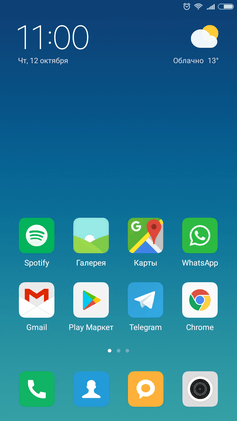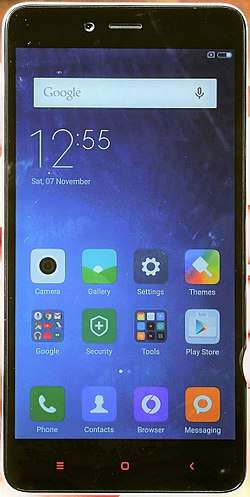MIUI
 | |
 MIUI 9 interface screenshots | |
| Developer | Xiaomi |
|---|---|
| Written in | C, C++, Java |
| OS family | Unix-like |
| Working state | Current |
| Source model | Open source (Android Base and Main Framework) with Proprietary components (Miui Apps and Kits) |
| Initial release | 0.8.16 / 16 August 2010 |
| Latest release |
MIUI: 10.0.2.0 China 10.0.2.0 Global / July 10, 2018 |
| Latest preview |
MIUI 10 Beta: 8.9.25 Global (30 August 2018) China Stable has been released |
| Marketing target |
Alternative firmware replacement for Android devices; Stock firmware for Xiaomi mobile devices |
| Available in | 32 languages (varies by country) |
| Package manager |
Google Play (Global) MI App Store (China) APK files |
| Platforms | 32-bit ARM, MIPS, x86, x64 |
| Kernel type | Monolithic, modified Linux kernel |
| License |
Apache License 2.0 GNU General Public License v3 Proprietary |
| Official website |
en |
MIUI (abbreviation of MI User Interface and pronounced as "Me You I")[1] is a stock and aftermarket firmware for smartphones and tablet computers developed by Xiaomi.[2] The firmware is based on Google's Android operating system.[3] MIUI includes various features such as theming support.[4]
Xiaomi has released various smartphones, all but Mi A1, Mi A2 and Mi A2 lite of which come pre-installed with a complete version of MIUI.[5] This has made various apps and features not available in the aftermarket version of MIUI.
Other than supporting their in-house smartphones and tablets, Xiaomi also offers MIUI to be flashed on other smartphone brands such as Samsung, Sony, HTC, BLU, OnePlus and Nexus.
On February 24, 2016, Xiaomi said that the MIUI ROM had over 170 million users worldwide, and was supported on over 340 handsets.
Development
The original MIUI ROMs were based on the Android 2.2.x Froyo and was initially developed in the Chinese language by Chinese startup Xiaomi Tech.[6] Xiaomi added a number of apps to enhance the basic framework; those include Notes, Backup, Music, and Gallery.[7] MIUI used to be translated and ported into unofficial versions in other languages by independent developers and groups of fansites. There are still unofficial ports being made but their popularity decreased after Xiaomi released their own cell phones. Updates are usually provided over-the-air every Thursday (CST).
MIUI and Google Play Services
Google has had disagreements with the Chinese government, and access to many Google services is blocked. MIUI does not ship with Google Play Services in mainland China. However, Xiaomi has expanded its operations outside China; MIUI releases for Android devices outside mainland China have Google Play Services and Google Apps such as Gmail, Google Maps, Google Play Store pre-installed and functioning as on any other Android device. MIUI global versions are certified by Google.
Comparison of all MIUI variants
| China | Global | Xiaomi.eu | ||||
|---|---|---|---|---|---|---|
| Languages available | Few, including Chinese and English | Wide selection | ||||
| Selection of downloadable themes | All | Some | ||||
| Drag up search | Yes
with international Bing and selection of Chinese search engines |
Yes | ||||
| Smart Assistant | App vault | |||||
| Default source of apps | Mi App Store | Google Play
Additionally in India: Mi Picks[8] |
Google Play | |||
| Mi Cloud services | All | Some | All | |||
| Updates | Developer | Stable | Beta | Stable | Dev/Beta | Stable |
| Highest priority.
Updated every Thursday |
Usually updated every two months[9] | Updated every Thursday | Usually updated every two months | Updated every Friday | Usually updated every two months | |
| OTA | Yes | Yes; patches are not supported, so a complete new ROM is downloaded each time | ||||
| Official | Yes (made by Xiaomi) |
Approved by the official distribution in the European Union.
Use on devices from the EU distribution does not void warranty.[10] Made by fans gathered on Xiaomi.EU website. | ||||
| Custom recovery requirement | No | Yes | ||||
| Additional features |
|
Optional access to various Chinese online services | N/A |
| ||
| Supported Xiaomi devices | All
excluding Redmi Note 3SE and Mi 4i (dropped) Older devices may not be updated |
Majority
excluding devices never released outside PRC Older devices may not be updated |
All cell phones
excluding Mi 4i (dropped) Older devices may not be updated | |||
MIUI vs. Android
Although the MIUI is built on the Android platform, the default user interface of its earlier iterations closely resembled iOS due to the absence of the application tray[11] with a grid of icons arrayed in the home panels. Other iOS similarities include the app icons being in a uniform shape, the dialer and in-call interface, the organization of the Settings app, and the visual appearance of toggles in the UI. This prompted some observers to cite how the devices running on MIUI could appeal to iOS users wanting to switch to the Android platform.[11] Recently, however, MIUI is increasingly shifting towards a design aesthetic that is more similar to the stock Android. Reports indicate, for instance, that several elements in the MIUI 10 build will closely resemble what Android P has brought into the table such as the multitasking menu and gesture controls.[12] This change was first seen in the MIUI 9 (ver. 8.5.11) that shipped with the Xiaomi Mi Mix 2S. The MIUI firmware already looked like stock Android P.[13]
Another key difference that distinguishes MIUI from Android is the system's support for themes. Users can download theme packs from the Mi Market, which could drastically change the user interface of the device once installed. It even allows advanced users to tweak the hard-coded firmware of their handsets.[14]
Criticisms and controversies
MIUI's kernel was proprietary, and in breach of Linux kernel's GPL.[15][16] Due to criticism, source code for certain components was released to GitHub on 25 October 2013.[17] Kernel sources for a limited number of devices, including the Mi3, Mi4, MiNote, and Redmi 1S, were released in March 2015.[18]
Since MIUI V4, based on Android Ice Cream Sandwich and Jelly Bean, Xiaomi added a virus scanning engine from partner company Tencent (formerly from Kingsoft, whose CEO appears to be the same person) despite the opposition of many users. Methods of removing it were published in the MIUI's Chinese forum,[19] since the engine was not found to be helpful.[20]
Also during the development of MIUI V4, Xiaomi started to remove Google Mobile Services (GMS) from their ROMs because of Chinese government policies that arose in response to Google's disagreements with the Chinese government. The government blocked access to all Google services on every platform, in mainland China, and all phones made for the Chinese market are required not to allow the installation of GMS. GMS is present in the global variant of MIUI, however.
In order to raise funds for the company, MIUI has its own online services from Xiaomi, including cloud services, paid themes and games (featuring the MiCredit digital currency).[21]
Version history
| Version | Screenshot | Android version | Last Beta release | Initial Beta release | Date of release | Last Stable release | Notable change |
|---|---|---|---|---|---|---|---|
| MIUI V1 | 2.1 |
Unknown | 0.8.16 | 16 August 2010 | N/A | Initial release | |
| MIUI V2 | 2.1-2.3.6 |
Unknown | Unknown | Unknown | N/A | Redesigned user interface | |
| MIUI V3 | 2.3.6 | 2.4.20 | Unknown | Unknown | N/A | Redesigned user interface | |
| MIUI V4 | 4.0.4 – 4.1.2 | 3.2.22 | Unknown | Unknown | ICS24.0[22] |
| |
| MIUI V5 | 4.1.2 – 4.4.2 | 4.12.5 | 3.3.1 | 1 March 2013[23] | 22.0[24] |
| |
| MIUI 6 |  |
4.4.2 – 5.0.2 | 5.8.6 | 4.8.29 | 29 August 2014[25] | 6.7.2.0 | New user interface |
| MIUI 7 |  |
4.4.2 – 6.0.1 | 6.5.26 | 5.8.13 | 13 August 2015[26] | 7.5.1.0 | Locked bootloader on selected old devices and all released afterwards |
| MIUI 8 | 4.4.2 – 7.1.1 | 7.7.20 | 6.6.16 | 16 June 2016[27] | 8.5.10.0 |
| |
| MIUI 9 |  |
4.4.2 – 8.1.0 | 8.5.24 | 7.8.10 | 10 August 2017 | 9.6.5.0 |
|
| MIUI 10 | 6.0 – 9.0.0 | 8.9.25 | 8.6.14 | 19 June 2018[28] | 10.0.2.0 |
|
See also
References
- ↑ About MIUI Video on YouTube
- ↑ [Announced]50 Beta Testers Wanted for Official nexusUI for Nougat 7 II. Apply here, MIUI, 26 February 2014, retrieved 5 March 2014
- ↑ http://tech.sina.com.cn/t/2011-07-28/01255847379.shtml
- ↑ MIUI Official English Site, en.miui.com, archived from the original on 15 February 2014, retrieved 16 March 2014
- ↑ Xiaomi Phone with MIUI OS: a $310 Android with 1.5 GHz dual-core SoC and other surprises, Engadget, 16 August 2011, retrieved 17 September 2011
- ↑ Jason Lim, MIUI, Lei Jun, TechNode, retrieved 17 January 2012
- ↑ MIUI Official English Site, archived from the original on 9 April 2014, retrieved 12 April 2014
- ↑ Forum, Xiaomi MIUI Official. "Mi Picks - pick your next favorite- officially launched! Give us your feedback! - App - Xiaomi MIUI Official Forum". en.miui.com. Retrieved 2018-02-15.
- ↑ "MIUI ROM Downloads". en.miui.com. Retrieved 2018-04-28.
- ↑ "MIUI 9 - 7.8.10 - First Miui 9". Xiaomi European Community & Store. Retrieved 19 September 2017.
- 1 2 Black, Marie. "What's the difference between TouchWiz, MIUI, EMUI, OxygenOS, LG UX and standard Android?". Tech Advisor. Retrieved 2018-07-31.
- ↑ "MIUI 10 To Offer Updated Design, Its User Interface Leaks | Androidheadlines.com". AndroidHeadlines.com |. 2018-05-29. Retrieved 2018-07-31.
- ↑ "Latest MIUI 9 build for the Xiaomi Mi Mix 2 brings Android P-style UI changes". xda-developers. 2018-05-11. Retrieved 2018-07-31.
- ↑ Pfeffermann, Nicole; Gould, Julie (2017). Strategy and Communication for Innovation: Integrative Perspectives on Innovation in the Digital Economy. Cham, Switzerland: Springer. p. 30. ISBN 9783319495408.
- ↑ "小米的MIUI被指违反GPL许可证" (in Chinese). Solidot. 21 November 2012. Retrieved 6 August 2013.
- ↑ "MIUI is accused of non-compliance with free software license, users request MIUI to be free software (MIUI被指责不遵守开源软件协议,网友要求公开源代码)" (in Chinese). tech2ipo. 21 November 2012. Retrieved 6 August 2013.
- ↑ "Commits". GitHub. 25 October 2013.
- ↑ GitHub MiCode/Xiaomi_Kernel_OpenSource, GitHub, 31 March 2015, retrieved 8 April 2015
- ↑ "Search Results for virus scanning engine".
- ↑ "【实机亲侧】MIUI自带病毒扫描无任何安全防护作用!".
- ↑ "删除谷歌,内置杀毒,MIUI终于突破底线".
- ↑ "MIUI Official English Site - Redefining Android". 2013-12-06. Retrieved 2018-05-22.
- ↑ Forum, Xiaomi MIUI Official. "MIUI ROM 3.3.1 Changelog: MIUI V5 for Xiaomi MI2 Released!!! - MIUI General - Xiaomi MIUI Official Forum". en.miui.com. Retrieved 10 February 2017.
- ↑ Forum, Xiaomi MIUI Official. "MIUI Stable ROM (Global) KXDMIBF22.0 for MI3-WCDMA/CDMA Changelog & Download - Xiaomi Mi 3 - Xiaomi MIUI Official Forum". en.miui.com. Retrieved 2018-05-05.
- ↑ Forum, Xiaomi MIUI Official. "MIUI ROM 4.8.29 Full Changelog. MIUI 6 Released for Public! (Released) - MIUI General - Xiaomi MIUI Official Forum". en.miui.com. Retrieved 10 February 2017.
- ↑ Forum, Xiaomi MIUI Official. "About MIUI 7 China ROM 5.8.13. What Device Will MIUI 7 Global ROM Support First? - MIUI General - Xiaomi MIUI Official Forum". en.miui.com. Retrieved 10 February 2017.
- ↑ Forum, Xiaomi MIUI Official. "MIUI 8 China Developer ROM 6.6.16 Full Changelog & Supported Devices - MIUI General - Xiaomi MIUI Official Forum". en.miui.com. Retrieved 10 February 2017.
- ↑ "MIUI 10首批机型公测下载 - MIUI官方网站". www.miui.com. Retrieved 2018-06-21.

